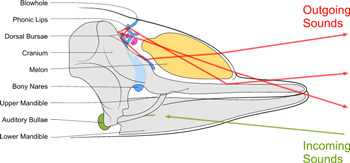You are hereProjects/ 4-channel UDDAS/ Dolphin acoustics - part 2
Projects/ 4-channel UDDAS/ Dolphin acoustics - part 2
PREVIOUS: Echolocation
INTRODUCTION TO DOLPHIN ACOUSTICS - part II
Sound production and reception
 Dolphins emit sounds from their forehead. Rapid sequences, or “trains” of echolocation clicks are produced by the so-called phonic lips in the dolphin blowhole. This is enabled by a system of airsacs that pump the air around. There are two pairs of phonic lips on either side of the head, which can produce click trains independently of each other. The sounds are then guided through the melon, a melon-shaped fatty structure in the dolphin forehead with special acoustic properties. These properties help to make the transition of the sound from air to water with a minimum of energy loss, and to also focus the sound into a narrow beam (somewhat like the light beam coming from a miner’s helmet).
Dolphins emit sounds from their forehead. Rapid sequences, or “trains” of echolocation clicks are produced by the so-called phonic lips in the dolphin blowhole. This is enabled by a system of airsacs that pump the air around. There are two pairs of phonic lips on either side of the head, which can produce click trains independently of each other. The sounds are then guided through the melon, a melon-shaped fatty structure in the dolphin forehead with special acoustic properties. These properties help to make the transition of the sound from air to water with a minimum of energy loss, and to also focus the sound into a narrow beam (somewhat like the light beam coming from a miner’s helmet).
 After the echoes bounce off an object and return, they are picked by the dolphin’s lower jaw, which contains the same “acoustic fat” as the melon does. Two elongated stretches of this fat in the jaw act in a way like giant antennas or receivers, that guide the echoes from the water into each middle ear, after which they are processed by the brain.
After the echoes bounce off an object and return, they are picked by the dolphin’s lower jaw, which contains the same “acoustic fat” as the melon does. Two elongated stretches of this fat in the jaw act in a way like giant antennas or receivers, that guide the echoes from the water into each middle ear, after which they are processed by the brain.